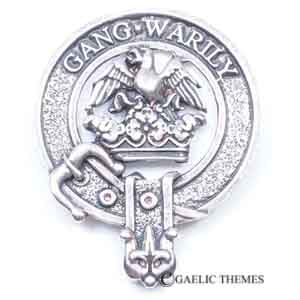Drummond
Select
- Clan Motto: Gang Warily
- Notes:
Crest: On a crest coronet Or, a goshawk, wings displayed Proper, armed and belled Or, jessed Gules
Centered on the edge of the Highlands, the Drummonds are a long-lived and influential clan whose fortunes have risen and fallen with Scottish history.
Their home parish of Drymen lies to the west of Stirling. The name comes from the Gaelic ‘Dromainn’ (“ridge”). According to legend, the first nobleman to settle at Drymen was a Hungarian who accompanied Edgar the Aetheling when he fled to Scotland in 1067 to escape William the Conqueror. The first chief of record was Malcolm Beg, Chamberlain of Lennox and husband of Ada, daughter of the Earl of Lennox in the 13th century.
Gilbert de Dromund of Dunbarton is listed on the ‘Ragman Roll’ of Scottish nobles who swore fealty to Edward I of England in 1296. Malcolm de Drummond also swore fealty at this time. However, it seems this was just lip service to an enemy for the Drummonds later fought for the Bruce. In fact after the Battle of Bannockburn, the king granted them lands in Perthshire. The caltrops shown in the Drummond arms allude to Sir Malcolm’s use of these weapons against the English cavalry.
The Drummonds were always proud Jacobites, starting with their support of the Royalists in the Civil War. They fought with Montrose in 1645. James, the fourth earl, was made Lord High Chancellor of Scotland in 1684. When James VII acceded the throne, he declared himself Catholic, gaining high favor with the Catholic monarch. Earl James was a founder knight of the revived Order of the Thistle. The family also suffered for their loyalty to James VII. Earl James was imprisoned for four years and later joined the exiled court in France. His brother, the earl of Melfort, followed the king on his unsuccessful campaign in Ireland in 1690.
James Drummond, (later the second duke) joined in the uprising of 1715 during which he seized Edinburgh castle and commanded mounted troops at the battle of Sheriffmuir. The third duke, followed the Bonny Prince in 1745 and captured Carlisle, England. At Culloden he commanded the left flank. The family survived the uprising thanks to their presence in France, but in Scotland their lands were forfeited. In 1853, George Drummond was restored by Parliament Earl of Perth. The Drummond family castle, built in the 15th century, is located at Concraig and is now the seat of the Earls of Ancaster (the Drummond-Willoughbys).
